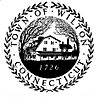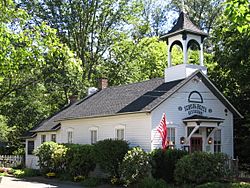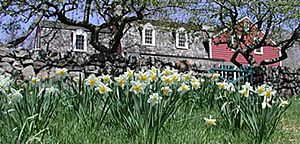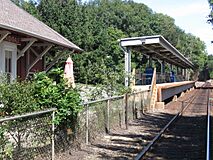Wilton, Connecticut facts for kids
Quick facts for kids
Wilton, Connecticut
|
||
|---|---|---|
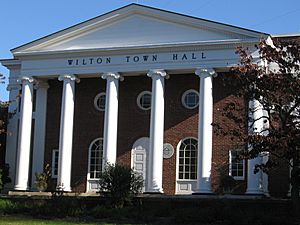 |
||
|
||
 Fairfield County and Connecticut Fairfield County and Connecticut Western Connecticut Planning Region and Connecticut Western Connecticut Planning Region and Connecticut |
||
| Country | United States | |
| U.S. state | Connecticut | |
| County | Fairfield | |
| Region | Western CT | |
| Incorporated | 1802 | |
| Government | ||
| • Type | Selectman-town meeting | |
| Area | ||
| • Total | 27.3 sq mi (71.0 km2) | |
| • Land | 26.9 sq mi (69.8 km2) | |
| • Water | 0.4 sq mi (1.1 km2) | |
| Elevation | 335 ft (102 m) | |
| Population
(2020)
|
||
| • Total | 18,503 | |
| • Density | 677.8/sq mi (260.61/km2) | |
| Time zone | UTC−5 (Eastern) | |
| • Summer (DST) | UTC−4 (Eastern) | |
| ZIP Code |
06897
|
|
| Area code(s) | 203/475 | |
| FIPS code | 09-86370 | |
| GNIS feature ID | 0213535 | |
Wilton is a town in Fairfield County, Connecticut, United States. As of the 2020 census, the town population was 18,503. The town is part of the Western Connecticut Planning Region.
Officially recognized as a parish in 1726, Wilton today is a residential community with open lands, historic architecture such as the Round House, and many colonial homes. Many residents commute to nearby cities such as Stamford or New York City.
Wilton is home to many global corporations such as ASML, Breitling SA, Cannondale Bicycle Corporation, Melissa & Doug, and formerly Deloitte. It is also home to AIG Financial Products, whose collapse played a pivotal role in the financial crisis of 2007–2008.
The transformation from a small farming town to a suburban residential community has been carefully controlled by zoning, efforts to preserve the town's colonial landmarks, and the reservation of almost 1,000 acres (4 km2) of open space for active and passive recreational use. The Cannondale Historic District, in north-central Wilton, retains its historic character and was listed on the National Register of Historic Places in 1992.
Contents
History
Colonial days
The first written records of the areas that are now Wilton date back to 1640, when Roger Ludlow and his friends purchased land from the Indians between the Norwalk and Saugatuck Rivers and "a day's walk into the country." This land was called Norwalk.
The first settlers, called the Proprietors, arrived in Norwalk in 1651 and owned 50,000 acres (200 km2) in common. On the outskirts of Norwalk's settled area, the Proprietors were allowed private ownership of land in a common planting field, but cattle, sheep, and hogs were grazed in a communal pasture area. The outer limit of this pasture approximates Wilton's present southern boundary.
By the end of the 17th century, the Norwalk Proprietors began to sell off the northern lands for settlement. The first non-Indian settlements in what is now Wilton were in the fertile lands of the Norwalk River valley, and on the ridges of Belden Hill, Chestnut Hill, and Ridgefield Road. In order to till the lands, the settlers had to clear the forests and remove hundreds of glacial rocks, which became the stone boundary walls that are treasured today.
The families who bought land in Wilton did not have their own church and were required to attend service in Norwalk each Sunday. When demand for Wilton lands increased in the early 18th century, the Proprietors realized that the land would be worth more if Wilton settlers did not have to make such a long trek each week.
By 1725 there were forty families living in Wilton who wanted their own Congregational church and were allowed by Norwalk to hire a minister (Robert Sturgeon, who also became the town's first schoolmaster), open schools and build roads. Therefore, in 1726, with the approval of both the Proprietors and the Wilton settlers, a petition to the General Court in Hartford created Wilton Parish, "a village enjoying parish privileges" but still part of the town of Norwalk. A copy of the petition is framed and on display in the Town Hall. (See also: Benjamin Hickox)
The Wilton Parish, organized as an ecclesiastical society, dealt with many problems of a secular nature as well. It dealt with such things as communal flocks, pounds for animals, and the regulation of the trades and taverns. The state of the roads was a constant source of comment in the society meeting, as was the inevitable subject of taxation. Although the village parish did not have the right to send a representative to the state legislature, it did have complete charge of both local education and military training. The first minister, Mr. Robert Sturgeon, was also Wilton's first schoolmaster.
As soon as the first meetinghouse was built in 1726, Wilton had a "center" of town, although other areas such as Belden Hill, Drum Hill, Pimpewaug and Chestnut Hill had already been settled by self-sufficient farmers. By 1738 the first meetinghouse had become too small, and a second was built on the corner of Sharp Hill Road. Less than sixty years later, this second meeting house had fallen into such disrepair that a third church was built in 1790 on Ridgefield Road where it still stands as the oldest church building in Fairfield County, Connecticut.
Revolutionary War
During the Revolutionary War, more than 300 men from Wilton served in some military unit. Among them was an African American named Cato Treadwell (1762–1849), who served three years in the 2nd Brigade of the Connecticut Line. In 1777, British forces passed through Wilton after raiding nearby Danbury. Several homes were burned along Ridgefield, Belden, Danbury, and Dudley roads, but the town remained intact. About 52 Revolutionary veteran graves are still identifiable in Wilton cemeteries.
19th century
In 1802, despite Norwalk's objections, the people of Wilton sought and were granted separate Town government status by an act of the Connecticut General Assembly and became a political entity independent from Norwalk. The town chose the traditional New England Town Meeting-Selectmen form of government, which has been retained to this day.
In the 19th century, education became the responsibility of the school societies of nine separate school districts in Wilton. In addition, many Wilton children and those of well-to-do families of Norwalk and Stamford attended five private schools and academies in Wilton.
Wilton's population grew slowly from 1,728 in 1810 to 2,208 in 1860. Most of the land was farmland used for dairy herds, horses, or marketable crops. Farmers found their yield from the rocky soil to be very low at the same time that midwestern produce, made readily available by the railroads, began to compete with homegrown products, home industry expanded.
Industries such as shoemaking, shirt making, carriage building, and distilleries were common. Mills of various types were built along the streams and the Gilbert and Bennett Manufacturing Co. began producing wire sieves in 1834.
Civil War
Before the Civil War, the anti-slavery movement was strong in town. Wilton served as one of the stops on the Underground Railroad, a loosely organized escape route to Canada for runaway slaves, primarily at the house of William Wakeman, "an earnest abolitionist and undergrounder for many years." The Civil War itself had little impact on Wilton, although local businesses profited from wartime spending.
Industrial age
The coming of the railroad in 1852 brought few advantages to a community of home industry and farming, but offered easy access to bountiful western lands.
After the Civil War, Wilton's population declined as cities grew, industrialization increased, the market for home products dropped, and farms were abandoned. Its population declined by some 30% between 1860 and 1900. By 1900, the census showed only 1,598 people living in Wilton.
This depopulation enabled many 18th- and 19th-century homes to escape demolition and suburban development. Beginning in the 1910s, abandoned farms were discovered by New Yorkers for summer homes and in the 1930s, there were noticeable stresses at Town Meetings between the "old-timers" and the "new people." The community was changing from agricultural to one of commuters. By 1935, the last two of Wilton's nine schoolhouses—Belden Hill and Hurlbutt Street—had closed. The original nine school districts are consolidated into the Center school in Wilton Center.
Originating in its colonial origins, Wilton had developed in a rather haphazard, individualistic way: a house here and a store there. Shortly after World War II, a new phenomenon brought a new look to Wilton's landscape: the builder subdivision.
Light industry began moving into town. To plan for orderly growth, town zoning was adopted. With the growth in population and businesses came the corresponding need for new schools, new roads, executive offices, and more support services. The period of greatest growth was from 1950 to 1970, when the population grew from 4,558 to 13,572.
Dry to damp
Wilton was classified as a "dry" town until 1993, when the local ordinance was altered to permit the sale of alcoholic beverages in restaurants. The town was then referred to as "damp." On November 5, 2009, a referendum proposal was passed to allow liquor stores.
Wilton deaths on September 11, 2001
On September 11, 2001, four town residents died in the terrorist attack on the World Trade Center: Edward T. Fergus Jr., 40; Peter Christian Fry, 36; John Iskyan, 41; and Edward P. York, 45. Wilton High School graduate John Henwood, 35, also died in the attack.
Geography
According to the United States Census Bureau, the town has a total area of 27.4 square miles (71 km2), of which 27.0 square miles (70 km2) is land and 0.4 square miles (1.0 km2), or 1.50%, is water, including the South Norwalk Reservoir. Wilton is bordered by Ridgefield to the northwest, Norwalk to the south, New Canaan to the southwest, Westport to the southeast, and Weston and Redding to the northeast. It is also bordered on the west by the hamlet of Vista in Lewisboro, Westchester County, New York.
Housing and land use
Wilton has about 500 surviving 18th- and 19th-century homes. In 2005, Marilyn Gould, the director of the Wilton Historical Society said:
People aren't taking down historic houses but the more modest homes that were built in the '50s and '60s.... What that's doing is changing the affordability of the town and the demographic of the town. Wilton used to have a wide demographic of people who worked with their hands—artisans, builders, mechanics. Now it's management and upper management.
Between 1999 and 2005, the town's voters endorsed spending $23 million through municipal bonds to preserve land.
South Norwalk Electric and Water (SNEW) has a reservoir on the western side of town with about 350 acres (1.4 km2) of land, along with another 25 acres (100,000 m2) adjacent in New Canaan. In the fall, hunters with bows and arrows—no more than 10 at a time—are allowed to hunt deer on the Wilton property, in order to keep down the number of deer in the area.
Wilton town center contains several local restaurants, boutiques, retail stores .These stores were added around 2000 next to the old Wilton Center, which consists of the Wilton Library, the Wilton Post Office, the Old Post Office Square, and the Village Market. In the southern part of town, US 7 contains a business district.
Recent nature access developments in town include the expansion of the Norwalk River Valley Trail, a multi-use trail designed to run between Norwalk and Danbury.
Neighborhoods
The southwestern corner of town includes part of the Silvermine neighborhood (which also extends into New Canaan and Norwalk). Georgetown, which is primarily within the town but also extends into Redding and partly into Weston, is in the northeastern corner of town. Other neighborhoods in town are South Wilton, Wilton Center, Gilbert Corners, Cannondale, and North Wilton.
Demographics
| Historical population | |||
|---|---|---|---|
| Census | Pop. | %± | |
| 1820 | 1,818 | — | |
| 1850 | 2,066 | — | |
| 1860 | 2,208 | 6.9% | |
| 1870 | 1,994 | −9.7% | |
| 1880 | 1,864 | −6.5% | |
| 1890 | 1,722 | −7.6% | |
| 1900 | 1,598 | −7.2% | |
| 1910 | 1,706 | 6.8% | |
| 1920 | 1,284 | −24.7% | |
| 1930 | 2,133 | 66.1% | |
| 1940 | 2,829 | 32.6% | |
| 1950 | 4,558 | 61.1% | |
| 1960 | 8,026 | 76.1% | |
| 1970 | 13,572 | 69.1% | |
| 1980 | 15,351 | 13.1% | |
| 1990 | 15,989 | 4.2% | |
| 2000 | 17,633 | 10.3% | |
| 2010 | 18,062 | 2.4% | |
| 2020 | 18,503 | 2.4% | |
| U.S. Decennial Census | |||
As of the census of 2000, there were 17,633 people, 5,923 households, and 4,874 families residing in Wilton. The population density was 654.3 inhabitants per square mile (252.6/km2). There were 6,113 housing units at an average density of 226.8 per square mile (87.6/km2). The racial makeup of the town was 95.55% White, 0.60% African American, 0.09% Native American, 2.69% Asian, 0.01% Pacific Islander, 0.27% from other races, and 0.79% from two or more races. Hispanic or Latino of any race were 1.53% of the population.
There were 5,923 households, out of which 46.6% had children under the age of 18 living with them, 75.4% were married couples living together, 5.4% had a female householder with no husband present, and 17.7% were non-families. Of all households 15.3% were made up of individuals, and 6.6% had someone living alone who was 65 years of age or older. The average household size was 2.91 and the average family size was 3.25.
The age distribution is 31.5% under the age of 18, 2.8% from 18 to 24, 25.6% from 25 to 44, 27.9% from 45 to 64, and 12.2% who were 65 years of age or older. The median age was 40 years. For every 100 females, there were 93.9 males. For every 100 females age 18 and over, there were 86.2 males.
The median income for a household in the town was $197,428, and the median income for a family was $217,415. Males had a median income of $190,000 versus $71,611 for females. The per capita income for the town was $65,806. About 1.3% of families and 2.9% of the population were below the poverty line, including 1.7% of those under age 18 and 6.6% of those age 65 or over.
Arts and culture
Events
- Relay for Life
- Wilton Singers Holiday Feast - traditional holiday performance, usually first weekend in December, featuring the Wilton Singers and the Wilton High School Madrigal Singers.
- Jazz in the Garden takes place at Weir Farm every September.
- Wilton Rocks for Food is an annual concert by Wilton-based musicians who send all the proceeds to the Wilton Food Pantry and the Connecticut Food bank.
- Wilton Farmers' Market is an outdoor farmers' market held at the Wilton Historical Society on Wednesdays from June through October.
- Wilton's annual Street Fair & Sidewalk Sale is an outdoor sales event in the town center that occurs in the summer.
Listings on the National Register of Historic Places
- Cannondale Historic District
- David Lambert House
- Georgetown Historic District
- Hurlbutt Street School
- Marvin Tavern
- Sloan-Raymond-Fitch House
- Weir Farm National Historic Site
- Wilton Center Historic District
Parks and recreation
The Wilton Parks and Recreation Department offers a number of programs for all ages including pre-school programs, senior programs youth soccer and basketball. There are also many walking paths including part of the Norwalk River Valley Trail. Merwin Meadows is a picnic area for families with a pond, playground and athletic field.
Education
Public schools
A total of about 3,750 students attend the town's four public schools: two elementary schools, Miller-Driscoll School (Grades Pre-K–2) and Cider Mill School (3–5); one middle school, Middlebrook School (6–8); and one high school, Wilton High School, which has accelerated classes for gifted students, music and visual arts courses, and a resource center. The language laboratory teaches six languages: French, German, Spanish, Latin, classical Greek, and American Sign Language.
The elementary schools have class sizes typically ranging from 18 to 22 and a 19-to-1 student/teacher ratio.
Middlebrook has interdisciplinary instruction teams in languages and science, mathematics, social studies, computers, art, and gifted student instruction. Class sizes range from 20 to 25 with a student/teacher ratio of 13-to-1.
Private schools
There are four private schools in the town:
- Connecticut Friends School, a Quaker preschool
- Seven Acres Montessori School, preschool through eighth grade
- The Goddard School, a preschool.
- Zion’s Hill Preschool, a play-based learning preschool with programs for 2 - 5 year olds. https://www.ZHPP.org
Media
The Wilton Bulletin is a weekly newspaper published by Hearst Connecticut Media and formerly published by Hersam Acorn Newspapers. GOOD Morning Wilton is an online daily news website. Virgin Mobile Live, a 24-hour online radio service licensed by Virgin Radio, is based in Wilton. There is also the weekly Wilton Villager newspaper.
Infrastructure
Transportation
Highways
The town's main north-south roadways are U.S. Route 7 and Route 33. State highways Route 53 and Route 106 also run through the town. The nearby Merritt Parkway (Route 15) serves the town via the Route 33 exit (Exit 41, signed for Wilton/Westport) and the Route 7 exits (Exits 39B & 40B, signed for Danbury).
Railroad
The town has two railroad stations: Wilton near the town center and Cannondale. Both are served by Metro-North Railroad's Danbury Branch, which provides direct commuter train service south to Norwalk (15 minutes), Stamford (25 minutes), and New York City's Grand Central Terminal (90 minutes); and north to Danbury (33 minutes). Connections are available at Norwalk and Stamford to other Northeast Corridor stations like New Haven and Boston.
Wilton was previously served by a station called South Wilton (1852–1971) and Kent Road (1976–1994) and by the Georgetown station from 1852–1970.
Buses
The town is served by the 7 Link bus route of the Norwalk Transit District that runs between Norwalk and Danbury along the Route 7 corridor. A commuter shuttle bus during rush hours is also available between South Wilton and the South Norwalk railroad station on the New Haven Line.
Notable people
- Max Andrews (born 2004), soccer player
- Theodore Bikel (1924–2015), actor, long-time resident
- Jeremy Black, actor
- Linda Blair, actress
- Chance Browne, cartoonist of syndicated comic strip Hi and Lois
- Dik Browne (1917–1989), cartoonist, creator of Hägar the Horrible and Hi and Lois
- Dave Brubeck, prominent jazz musician
- David Canary (1938–2015), actor, All My Children and Bonanza
- Paul Dano, actor, 2002 graduate of Wilton High School
- Ray Dalio, founder of Bridgewater Associates, richest person in Connecticut, resident in late 20th century
- Matt Davies, Pulitzer Prize-winning political cartoonist
- George Devol, inventor, engineer and manager, founder of first industrial robotics company Unimation.
- Abby Elliott, actress/comedian, daughter of Chris Elliott
- Chris Elliott, actor/comedian
- Ace Frehley, guitarist for Kiss, lived in Wilton from 1979–1986
- Charles Grodin (1935–2021), actor
- Johnny Gruelle, artist who created Raggedy Ann and Raggedy Andy
- June Havoc, actress, who also renovated buildings to create the Cannon Crossing center of small shops. Her sister Gypsy Rose Lee frequently visited her
- Daryl Hawk, documentary photographer, explorer
- Sterling Hayden, actor
- Henry Hazlitt, economics columnist, author, Wilton resident c. 1960s-1980s
- Patty Hearst, known as Patricia Hearst-Shaw, heiress, kidnapping victim, and actress
- Lydia Hearst-Shaw, supermodel and heiress
- Russell Hoban, writer; Lillian Hoban, writer and illustrator; and their daughter Phoebe Hoban, journalist and biographer
- Richard C. Hottelet, broadcast journalist and commentator, last of the Murrow's Boys
- Ira Levin, writer, lived in Wilton in the 1960s and wrote in a March 27, 2007, letter to the New York Times that he based the fictional town of Stepford from his 1972 novel The Stepford Wives on Wilton
- Kristine Lilly, US Olympic Soccer Team, holds the world record for most professional soccer match appearances in history
- Katherine Maher, executive director of the Wikimedia Foundation
- Jay Manuel, America's Next Top Model director of photo shoots
- Joe Pantoliano, actor
- Ingri and Edgar Parin d'Aulaire, writers and illustrators of children's books
- Aldo Parisot, cellist
- Dean Parisot, film and television director
- Sarah Phillips, fashion designer
- Steve Phillips, former NY Mets General Manager and former ESPN baseball analyst
- Charles E. Pont, artist and Baptist minister, lived here from 1958 until his death in 1971
- Jane Powell and Dickie Moore, actress and former child actor
- Randy Rasmussen, former left guard of the New York Jets for 15 years (1967–1981), started in Super Bowl III
- Vicki Sue Robinson, actress and singer
- John Scofield, grew up in Wilton, jazz guitarist
- Frank Sesno, journalist and professor
- Zachary Cole Smith, frontman of DIIV, went to elementary and middle school growing up in the town
- Donald B. Verrilli Jr., U.S. solicitor general from 2011 to 2016, graduated Wilton High School in 1975
- Christopher Walken, actor
- Marcy Walker, actress, lived in Wilton during the early 2000s
- Emily Weiss, founder of Glossier
- Cathie Wood, founder of ARK Investment Management
See also
 In Spanish: Wilton (Connecticut) para niños
In Spanish: Wilton (Connecticut) para niños


